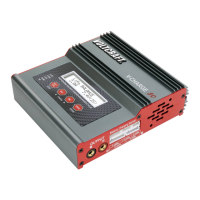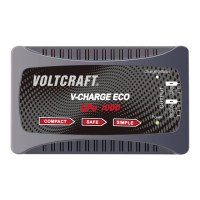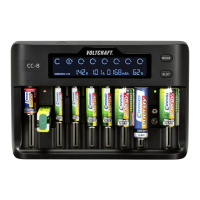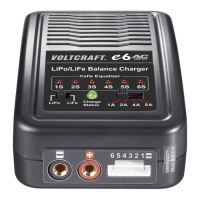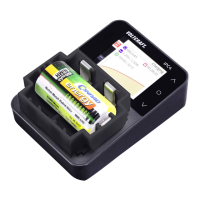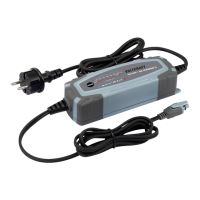• Hold down the "POWER ON/OFF" button for one second to switch on the battery charger. The
"AMP" LED lights up and "000" starts flashing on the display.
• On the battery, connect the red clamp with the positive terminal (+) and the black clamp with the
negative terminal (-). Observe the marking on the battery!
If you want to charge a vehicle battery without disconnecting it (see safety instructions at
the beginning of this section), you have to find out which pole of the battery is connected
to the vehicle body (minus for most vehicles) before connecting the battery charger.
Use a bare piece of metal (no painted metal). Moreover, it has to be as far away as
possible from the battery or fuel lines.
Negative terminal of the battery is connected to the body:
First connect the red clamp of the battery charger with the positive terminal (+) of the
battery. Then connect the black clamp with a bare piece of metal of the engine block.
Positive terminal of the battery is connected to the body:
First connect the black clamp of the battery charger with the negative terminal (-) of the
battery. Then connect the red clamp with a bare piece of metal of the engine block.
• Press the "2/6/12 AMP SELECT" button to select the charging current which is shown on the display.
The "AMP" LED lights up.
The charging current of a lead-acid storage battery should ideally be one tenth of the
battery's capacity in order to charge it gently. Excessive charging currents can damage
the battery!
Display shows "0": No charging current. The battery charger goes into standby mode.
Display shows "2": Charging current 2 A
Display shows "6": Charging current 6 A
Display shows "12": Charging current 12 A
• After setting the charging current, the charging process begins automatically and the "CHARGING"
LED lights up (charging begins). The selected charging current is shown on the display.
¼
You can abort the charging process by pressing the "2/6/12 AMP SELECT" button ("0" on the
display, see above) or change the charging current ("2" for 2 A, "6" for 6 A, "12" for 12 A).
• Press the "BATTERY VOLTAGE" button to see the battery voltage. The "VOLTAGE" LED lights up.
After a few seconds, the display switches back to the charging current.
• When the battery is fully charged, "FUL" appears on the display and the "FULL" LED lights up.
Trickle charging starts automatically. Press any button to go into standby mode and stop the
charging process.
• Disconnect the battery charger from the mains supply. First remove the clamp from the negative
terminal and then from the positive terminal.
DESCRIPTION OF LOAD CYCLE
ERROR MESSAGES
If the battery charger detects a mistake, an error message is displayed and the "FAULT" LED lights up.
See the following table for an explanation of the error messages.
voltage/current
time
constant
charging current
constant
charging
voltage
trickle charge
battery is full ("FUL" is displayed)
battery voltage
charging current
The charging process has three phases. First a constant charging current charges the battery to about
85 % of its capacity. In phase two, the battery charger provides a constant charging voltage with the
charging current declining. The battery is charged to about 95 % of its capacity.
In phase three, the battery charger switches to trickle charge and "FUL" is displayed. Trickle charge
prevents an overload of the battery and counterbalances its self-discharge.
USE AS 12 V POWER SOURCE
At the back of the battery charger there is a 12 V on-board power socket under a protective cap. It
provides 12 V for loads (e.g. a small size compressor to inflate the tyres).
Before connecting a load, make sure you have stopped the charging process and
disconnected the battery charger from the battery.
It is only permissible to connect loads with a power input that does not exceed 140 W.
The output voltage of the on-board power socket ranges between 13 V and 13.5 V (like
the on-board power socket of a vehicle). Do not power any products that require a
stabilised operating voltage of 12 V= (e.g. computers).
JUMP START
If the lead-acid storage battery of a vehicle is empty or too weak to start the motor, turn of the ignition.
Proceed as described in chapter "Charging a lead-acid storage battery". In this case, however, set a
charging current of 12 A and charge the battery for 5 minutes.
Then stop charging and disconnect the battery charger from the battery.
Try to start your vehicle again.
Error message
Legal notice
These operating instructions are a publication by Voltcraft®, Lindenweg 15, D-92242 Hirschau/Germany, Phone +49 180/586 582 7
(www.voltcraft.de).
All rights including translation reserved. Reproduction by any method, e.g. photocopy, microfilming, or the capture in electronic data
processing systems require the prior written approval by the editor. Reprinting, also in part, is prohibited.
These operating instructions represent the technical status at the time of printing. Changes in technology and equipment reserved.
© Copyright 2008 by Voltcraft®.
Possible causes, remedy
The battery charger has no battery connection or a short-circuit has been
detected. Properly attach the clamps to the battery.
The battery was connected the wrong way. The battery charger issues a
warning signal, no charging takes place. Turn off the battery charger and
remove the clamps from the battery. Connect them again according to the right
polarity.
Battery voltage is less than 5 V. The battery charger issues a warning signal,
no charging takes place. A totally discharged battery cannot be charged again.
Replace it with a new one.
The battery has an internal short-circuit (the battery charger has detected
leakage current), or the set charging current is too low. Select a higher
charging current. If the problem persists, replace the battery with a new one.
During the charging process a clamp got loose or a contact problem was
detected. The battery charger issues a warning signal every 25 seconds.
Charging is stopped for safety reasons. Make sure the clamps are properly
connected to the battery terminals and start charging again.
CLEANING
Disconnect the battery charger from the battery and the mains voltage before cleaning it. Clean the
outside with a clean, dry, soft cloth.
Do not use aggressive detergents, which might cause discolouration.
DISPOSAL
Product
At the end of its service life, dispose of the product according to the relevant statutory
regulations.
Lead-acid storage batteries
The end user is legally obliged (battery regulation) to return used storage batteries.
Disposal in the household waste is prohibited!
Storage batteries containing lead are marked with "Pb" written under a trashcan symbol.
This indicates disposal in the household waste is prohibited.
You can return used lead-acid storage batteries free of charge at the official collection
points of your community, in our stores, or wherever lead-acid storage batteries are sold!
You thus fulfil your legal obligations and contribute to the protection of the environment.
SPECIFICATIONS
Operating voltage: .................... 230 V~, 50 Hz
Max. power consumption: ........ 1.66 A
Rechargeable battery type: ...... 12 V lead-acid storage battery, min 6 Ah to max. 120 Ah
Charging voltage: ...................... 13.8 V
Charging current: ...................... 2, 6 or 12 A
Dimensions: .............................. 200 x 140 x 230 mm
Weight: ...................................... 1.2 kg
Vehicle on-board power socket at the back of the device:
Voltage output: .......................... 13.0 to 13.5 V
Output power: ........................... max. 140 W
Pb
Pb

